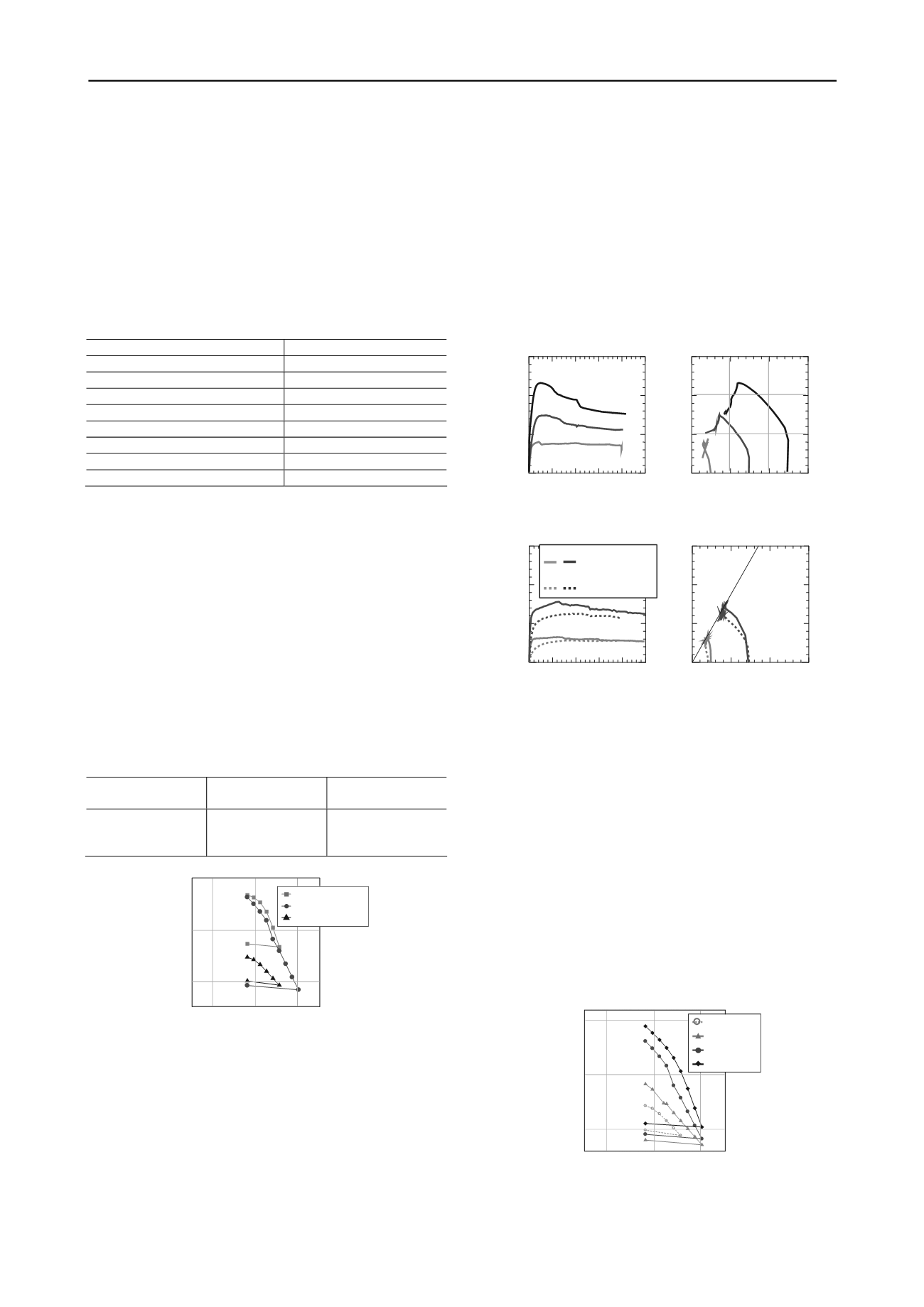
3240
Proceedings of the 18
th
International Conference on Soil Mechanics and Geotechnical Engineering, Paris 2013
plastic deformation. The SYS Cam-clay model defines
structure, overconsolidation, and anisotropy as the soil skeleton
structure, and an evolution rule is introduced that varies them in
accordance with the plastic deformation to reproduce the
mechanical behavior of natural deposited clay. This study
focused on structure and overconsolidation, controlling the ease
of change of their states using a degradation index of structure
and a degradation index of OCR in accordance with their
respective evolution rules (see Table 3), to explain the treated
soil as natural deposited clay and the remolded treated soil as
remolded soil.
Table 1 Physical properties of dredged soil
Soil particle density
ρ
s
[g/cm
3
]
2.67
Natural water content
w
n
[%]
50–110
Liquid limit
w
L
[%]
52.5
Plastic limit
w
p
[%]
25.1
Plasticity index
I
p
[%]
27.4
Clay content [%]
60
Silt content [%]
36.6
Sand content [%]
3.4
Mean grain diameter
D
50
[mm]
0.002
2 REPRODUCTION OF THE MECHANICAL BEHAVIOR
OF TREATED SOIL WITH SYS CAM-CLAY MODEL
2.1
Physical properties of dredged soil and treated soil
mixture conditions
Table 1 shows the physical properties of PI dredged soil.
Almost all of the soil is fine fraction with a high natural water
content, and it does not achieve the required strength. Also,
Table 2 shows the mixture conditions of the treated soil. In this
study, the mixture conditions were assumed to be a water
content
w
=120%, cement contents of
C
=30, 50, and 70 kg/m
3
,
and 28 days’ curing in order to ensure fluidity and strength for
the assumed Pneumatic Flow Method (Coastal Development
Institute of Technology 2008).
Table 2 Mixture conditions used in the comparison of cement content
Dredged soil water
content
w
0
[%]
Cement content
C
[kg/m
3
]
Water-cement ratio
W/C
120
30
50
70
25.2
15.0
10.6
10
–1
10
0
10
1
10
2
10
3
10
4
10
5
1.6
2
2.4
2.8
3.2
3.6
4
Vertical stress
σ
v
(kPa)
Specific volume
v
Treated soil
Remolded treated soil
Dredged soil
Figure 2. Comparison of uniaxial compression properties of treated soil,
remolded treated soil, and dredged soil
2.2
Mechanical behavior of treated soil (C=50 kg/m
3
) and
remolded treated soil and material constants
Fig. 2 shows the oedometer test results for treated soil and
remolded treated soil with C=50 kg/m
3
, together with the results
for dredged soil. Compared with dredged soil, treated soil has a
high initial specific volume, and as a result of cement addition,
it maintains the high specific volume state up to a certain
vertical stress. When the vertical stress exceeds a pseudo
consolidation yield stress, a high compressibility is exhibited.
Compared with the remolded treated soil, there is a certain
amount of structure up to the pseudo consolidation yield stress,
and when the vertical stress increases further, it gradually
approaches the compression line of the remolded treated soil.
Fig. 3 shows the CU triaxial test results for the treated soil, and
Fig. 4 shows the results for the remolded treated soil. The
behavior exhibited in Fig. 3 resembles the behavior of
overconsolidated and high structured clay (Asaoka et al. 2002).
As shown in Fig. 4, the behavior of remolded treated soil
resembles the behavior of dredged soil. However, the treated
soil has a specific volume that is distinctly higher than that of
dredged soil, so in Figs. 2 and 4, it is considered that remolded
treated soil is a material that is different from dredged soil.
0 5 10 15 20 25
0
200
400
600
0
200 400 600
0
200
400
600
Axial strain
a
(%)
Deviator stress
q
(kPa)
Mean effective stress
p
(kPa)
Deviator stress
q
(kPa)
Figure 3. Consolidated undrained triaxial test results for treated soil
0 5 10 15 20 25
0
200
400
600
0
200 400 600
0
200
400
600
Axial strain
a
(%)
Deviator stress
q
(kPa)
Mean effective stress
p
(kPa)
Deviator stress
q
(kPa)
q
=M
p
Remolded
treated soil
Dredged soil
Figure 4. Consolidated undrained triaxial test results for remolded
treated soil
2.3
Reproduction of the mechanical behavior of 3 treated
soils with different cement contents using the SYS Cam-
clay model
Treated soil was produced under the mixture conditions shown
in Table 2, and mechanical tests were carried out on them and
the remolded treated soil. Fig. 5 shows the results of oedometer
tests on remolded treated soil. For all cement contents, the
behavior was similar to that of remolded normally consolidated
soil, and as the cement content increased, the slope of the NCL
and the intercept N on the NCL increased. Fig. 6 shows the
CU test results for remolded treated soil. For each of the cement
contents, the behavior was similar to that of remolded soil, and
differences in cement content did not cause a major change in
the Critical state constant M. Based on the test results, the
elasto-plastic parameters in accordance with the differences in
cement content were assigned, as shown in Table 3.
10
–1
10
0
10
1
10
2
10
3
10
4
10
5
1.6
1.8
2
2.2
2.4
2.6
2.8
3
3.2
3.4
3.6
3.8
4
4.2
Verticalstress
σ
v
(kPa)
Specific volume
v
Specific olume
v
10 10 10 10
Vertic stress
σ
v
(kPa)
浚渫土
C=70kg/m
3
C=50kg/m
3
C=30kg/m
3
Dredged soil
Figure 5. Standard consolidation test results for 3 remolded treated soils


